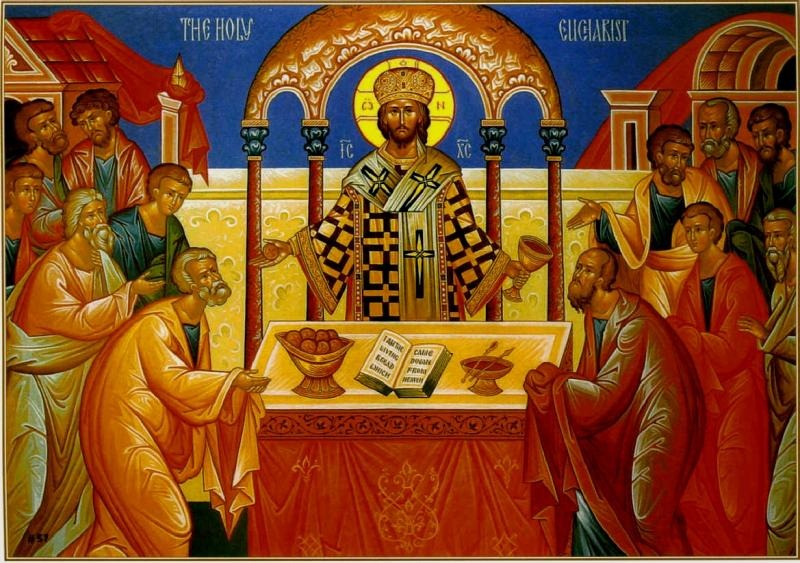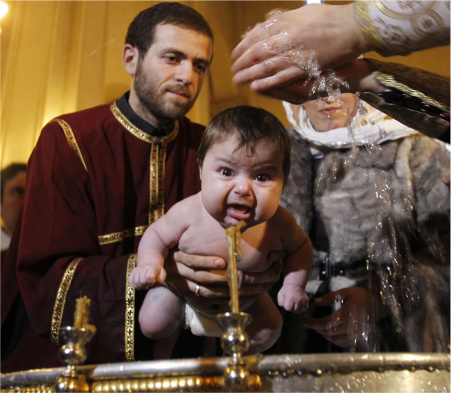Has the meaning of Christmas changed in recent years? Has the creeping commercialism of the past 40 years radically reshaped our understanding of Christmas? We learn in the news about Black Friday and Green Monday, about record sales and great bargains, and sadly about customers fighting other customers so they can get the perfect gift for their loved ones. Television shows talk about our having “the best Christmas ever!” It is as if Christmas is a rush that brings us perfect happiness. Perhaps this commercialization of Christmas has not corrupted the meaning of Christmas for many, but we suspect that it certainly has for millions. How did American culture go so wrong when it comes to celebrating Christmas?
Part of the problem is the fact that many people get much of their understanding of Christmas through the mass media which is heavily dependent on advertising revenue to survive. In many ways, this form of capitalist consumerism has come to dominate the Christmas season dangerously obscuring its traditional meaning.
If asked point blank about the meaning of Christmas, how would your 10-12 year old children answer? Could they discuss the central meaning of Christmas? What we really ought to celebrate in Christmas?
Rather than react negatively to all this, we can respond positively by learning from Saint Nicholas of Myra, the original “Santa Claus.” The name “santa” comes from the word “saint” and the name “Claus” is a shortened form of “Nicholas.” Unlike the modern mythical chubby figure who flies around the world on Christmas Eve in a sled pulled by flying reindeer there was a real live Santa in history. Nicholas of Myra lived in Asia Minor (modern day Turkey) in the fourth century. He was much beloved and shortly after he died he was remembered as a great saint by Christians in both the East and West. In recent years people have forgotten about the first Santa and were taught a “new and improved” Santa who brings lots and lots of toys to good girls and boys. For a discussion of how modern society redefined “Santa Claus” see my 2011 posting “Remembering St. Nicholas, Recovering a Christian Heritage.”
Learning from Saint Nicholas
Lesson 1 – Standing up for the Orthodox Faith
In Christmas we celebrate the birth of the Son of God who came into the world for our salvation. There is truth in the saying: “Christ is the reason for the season.” The true meaning of Christmas rests on right doctrine. A heretical understanding of Christ poses a deadly threat to the Christmas season. If Jesus is not truly the Son of God then Christmas is a waste of time. All the twinkling Christmas lights, Christmas caroling, and eggnog drink and cookies are all for nothing if Jesus is not the Son of God.
We do not celebrate Christ coming into our hearts spiritually at Christmas. No, the Christ of the Christmas season is the true Logos of God who comes physically into human history, taking on flesh “becoming Incarnate of the Virgin Mary” as the Nicene Creed so rightly says. God took on true humanity in Christ, becoming like us so He might redeem a fallen human race by conquering both sin and death. In the Incarnation the Word of the God invaded human history to rescue us. The birth of Christ is just as real as D Day (6 June 1945) when the Allied forces landed in Normandy to bring about the end of Hitler’s evil rule. Here, moderns might rightly say the Incarnation is “massive”!
We learn from Saint Nicholas the importance of holding to a right faith in Christ. Saint Nicholas was more than a nice guy. He was bishop of the church. As bishop he was responsible for guarding the Christian Faith. When the Arian heresy surfaced denying that Jesus Christ was truly divine, Bishop Nicholas and other bishops met to uphold Christ’s divinity: “true God of true God, begotten, not made, of one essence with the Father.” There is the story that at the Council of Nicea (AD 325) Nicholas was so upset at hearing Arius’ blasphemy that he slugged Arius in the face. This is a saint willing to fight for the faith! Not some jolly old man sitting in a chair with children on his lap.
Lesson 2 – Giving to the Poor
Santa’s big bag of toys and his surprise visits on Christmas Eve come from the story of a poor man who had three daughters. Because he could not afford to pay his daughters’ dowry they were in danger of being forced into prostitution in order to survive. Out of humility Nicholas would come in the middle of the night and throw in a bag of coin for each of the three daughters. When the father caught Nicholas in the act he began to thank him, but Nicholas stopped him saying that it was not him who should be thanked but God alone. In another version of the story the daughters would wash their stocking and hang them during the night to dry. Nicholas deposited gold coins in the stocking in the middle of the night to help them.
The story of Saint Nicholas rescuing the three young daughters can be applied to the modern problem of human trafficking. Human trafficking (sexual slavery, forced labor, or organ harvesting) is a humanitarian crisis today involving some 2.5 million people in over 120 countries (United Nations). Because poverty is one of the major driving forces underlying human trafficking — Almsgiving can be a major means of addressing this problem.
Almsgiving is more than writing out a check to a worthy cause; Christian almsgiving is rooted in a spirituality radically different from secular charity. I recommend the reader read Todd Madigan’s insightful “The Advent of Modern Almsgiving.”
In addition to supporting organizations that combat human trafficking, Orthodox Christians can also remember to pray for the victims and perpetrators during the Divine Liturgy. There is one petition that can apply to the issue of human trafficking:
For those who travel, by land, sea and air, for those who are sick or suffering or in captivity, and for their safekeeping, let us pray to the Lord.
Lesson 3 – Being Open to Miracles
Saint Nicholas is also known as Nicholas the Wonderworker. His life story is full of miracles and deliverances. He once went on a pilgrimage to Jerusalem by boat. Along the way the ship ran into a fierce storm that threatened to capsize the boat and take the life of all on board. Saint Nicholas prayed fervently for the safety of the passengers and in answer to his prayers the sea became calm once again. On another occasion he rescued three men who were unjustly accused by snatching the sword out of the executioner’s hand.
Nicholas’ charismatic ministry continued even after his death. He was buried in Myra and the town became a popular pilgrimage site. People would visit his grave site and ask for his prayers. When the Muslims conquered Asia Minor, a group of sailors hurriedly dug up Nicholas’ bones and transported them to the town of Bari in southern Italy. Parts of his relics were also taken to the city of Venice. His posthumous popularity among ordinary Christians can be traced to his devotion to Christ and his reputation as an effective intercessor.
Lesson 4 – Embracing Asceticism
From childhood Nicholas strove to live a holy life dedicated to Christ. At an early age he devoted himself to the reading of the Bible and other spiritual works. He gave himself to prayer day and night. He was the first to arrive at church. When his predecessor died an elderly bishop had a vision informing him that the first person to enter the church that night was to be made the next archbishop of Myra. When the saint arrived before anyone else he was stopped by the elder who asked him: “What is your name, child?” God’s chosen one replied: “My name is Nicholas, Master, and I am your servant.” Nicholas wanted to retire to the desert as a monk but he heard a voice telling him that this was not his calling. The Lord told Nicholas: “Nicholas, this is not the vineyard where you shall ear fruit for Me. Return to the world, and glorify My Name there.”
For modern day Orthodox Christians Saint Nicholas can serve as an example reminding us that devotion to God can be as simple as coming to the Liturgy on time. It is a sad fact that many Orthodox Christians straggle into the Sunday worship rather than eagerly participating in the Liturgy.
The ascetic life involves the disciplines of prayer, Bible reading, fasting, and almsgiving. All these spiritual disciplines can be found in the pre-Christmas fast observed by Orthodoxy. This is probably one of the biggest adjustments Protestants need to make when they become Orthodox. Many Protestants in America view the Christmas season as a joyful time of caroling, shopping, Christmas festivities, and children opening presents around the Christmas tree on Christmas morning. The notion of Lent during Christmas seems almost a contradiction in terms. Yet fasting and Christmas do go together. If Christmas is about preparing the way for the Son of God who would one day die on the Cross for our then fasting, mourning, and repentance are very appropriate ways for us to anticipate Christmas. Too many modern Christians take a pick-and-choose approach to spirituality. They choose only the feasting; historically, however, the church fathers taught feasting rests upon prior fasting. The cycle of fasting-feasting is an integral part of Orthodox spirituality. The Christmas Nativity is about the Christ Child who was born to rule and born to die. Thus, Christmas is both a time of joy and mourning (see Luke 6:20-26).
A “Countercultural” Approach to Christmas
Many Christians lament how Christmas has become commercialized and how the true meaning of Christmas has been lost. Rather than complain, we can respond positively by following the example of Saint Nicholas of Myra and observing Christmas the Orthodox way. The advantage of Orthodoxy’s Christmas Lent is that it is not a knee-jerk reaction to contemporary trends, but based on following Holy Tradition which has been passed down over many generations. This gives Orthodox Christians spiritual stability even as secular understanding of Christmas morphs in bizarre ways.
What can the Orthodox do to hold on to the true meaning of Christmas? We can make an effort honor Saint Nicholas on his feast day (December 6) at church even if it falls on the middle of the week. In the video below we see an Orthodox parish in San Anselmo, California, gathered on a Wednesday to celebrate St. Nicholas feast day.
http://www.youtube.com/watch?v=s2gr-JJjpEg
If we attend mid-week services to celebrate Saint Nicholas’ feast day that will surely make a huge impact on our children. We can tell them about Saint Nicholas’ devotion to prayer, fasting, and almsgiving as an example to follow during the Christmas fast.
We can support charitable organizations that help those in need. We can support organizations that combat human trafficking while we also pray more fervently when the Divine Liturgy exhorts us to pray for those “in captivity.” One possibility is supporting organizations like Samaritana – “Towards Prostitution-Free Societies.”
Parents can buy an icon of Saint Nicholas and teach their children about the first Santa Claus who was a real person who lived in the fourth century. Saint Nicholas’ life story is full of interesting and inspiring stories that we can pass on to our children. We can teach them the hymns of the church about Saint Nicholas. We can teach children that Saint Nicholas is in heaven praying for us.
O champion wonderworker and superb servant of Christ
thou who pourest out for all the world
the most precious myrrh of mercy
and an inexhaustible sea of miracles
I praise thee with love, O Saint Nicholas;
and as thou art one having boldness toward the Lord, from all dangers do thou deliver us,
that we may cry to thee: Rejoice, O Nicholas, Great Wonderworker!
In conclusion, celebrating Christmas in the spirit of Saint Nicholas is an act of radical discipleship. The original Saint Nicholas was not some jolly old man but a radical Christian. Let us learn from him and make our Christmas an Orthodox Christmas.
Robert Arakaki











Recent Comments